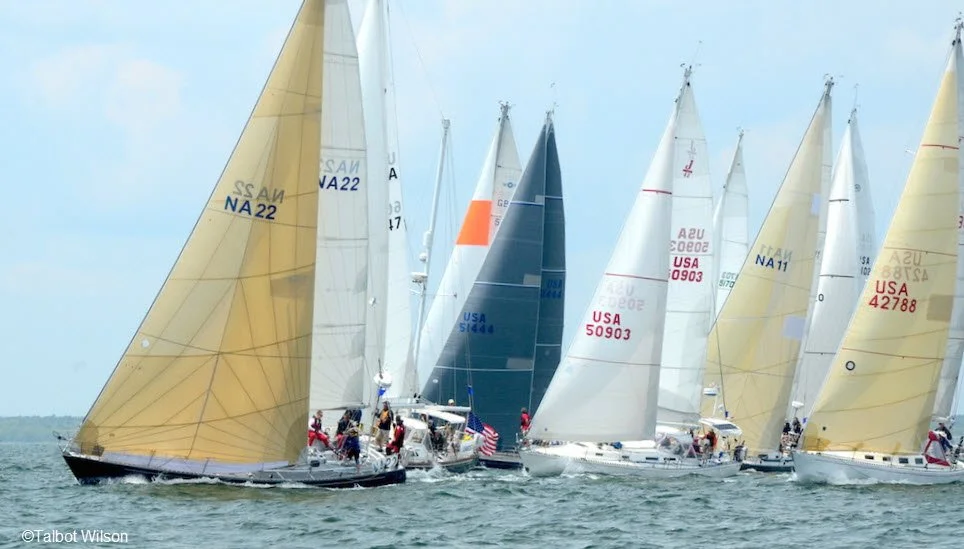91 Days to the Marion-Bermuda Race Start
Here’s a story about something inclusive, generous, community centred and adventurous coming out of America.
In the opinion of SWS The Marion Bermuda Race starting on 17th June, stands proudly amongst handful high profile sailing events that seem to be getting it right. In an editorial a few weeks ago we included the British Three Peaks Race (about to hold its 70th event), the Race to Alaska and the McIntyre Mini Global Race in the list of events that have got the balance right.
“The Marion-Bermuda Race was founded by two remarkable men: William David (”Dave“) Kingery and Geoffrey Richard (”Dickie“) Bird. In the summer of 1972 Kingery and his family arrived in Bermuda having spent a full year sailing from their summer home in Marion, Massachusetts to and from Tahiti aboard their 50’ Columbia sloop KERAMOS. Kingery, Bird, and their families met on the docks at the RHADC marina, quickly becoming close friends.
In January 1976 the Birds joined the Kingerys aboard KERAMOS for a cruise through the West Indies. It was on that trip that the two founders outlined the general principles of the first Marion-Bermuda race. Kingery was a member of the Beverly Yacht Club and on the Board of Governors of the Blue Water Sailing Club. Dickie Bird was a prominent member (later Commodore) of the Royal Hamilton Amateur Dinghy Club. They jointly proposed plans for a Marion to Bermuda race to the RHADC, the Blue Water Sailing Club, and to members of the Beverly Yacht Club. Support was promised from all three clubs. Ever since the first race in 1977, the Marion-Bermuda Cruising Yacht Race has had the continuous support of the two clubs at each end, and enthusiastic volunteers from the Blue Water Sailing Club. The BWSC also organizes the renowned Marion-Bermuda Safety at Sea Symposium held on behalf of the race each spring prior to the race.
The Race is built upon the competitive spirit and good fellowship of Corinthian sailing. It offers the unique opportunity to enjoy the camaraderie that develops from an offshore passage while testing one’s ability to reach the highest levels of teamwork racing a well-founded yacht. The Race believes this teamwork begins with the youth who represent the future of sailing and racing. We believe that sailing helps build leadership, personal responsibility, communication, problem solving and teamwork skills that will benefit and enhance their lives in the future. To fulfill our charitable mission each of the sponsoring yacht clubs use the proceeds of the race operations to support local programs that offer sailing and racing instruction to a diverse group of junior sailors. We hope to encourage their stewardship of, participation in and love of the sport.”
The 2015 start- Image Talbot Wilson
One of my favourite additions to the Notice of Race is Attachment A
ATTACHMENT A
CELESTIALLY NAVIGATED YACHT CLASSIFICATION REQUIREMENTS
CELESTIAL ELECTION
A yacht with a navigator skilled and experienced in celestial navigation at sea may elect to compete using celestial navigation. This election must be made in the online registration system on or before June 11, 2025.
NAVIGATION
During the race a boat’s location must be determined by traditional star, sun, planet or moon sights. Navigators of boats competing using celestial navigation must at a minimum maintain, and have ready for inspection in Bermuda, the paper-based plotting sheets for the entire race which demonstrate the method of obtaining the vessel’s position at any time during the race. All fixes resulting from Lines of Position shall have recorded the GMT, altitude, azimuth and intercept of the body or bodies of each LOP. Any Local Apparent Noon fixes shall have GMT and altitude data recorded and available for inspection. Most important will be the fix used to determine that the boat was, or was not, within 50 NM of Kitchen Shoals beacon.
The boat’s log must be maintained hourly and dead-reckoning positions must be easily derived from the log entries for any time during the race.
The Compliance Committee may ask a navigator to demonstrate how a particular fix on the plotting sheets was derived using the corresponding sight data.
NAVIGATION DEVICES
The following electronic navigation devices may be used throughout the race:
Knotmeter (not connected to GPS),
Log,
Compass,
Depth finder,
Wind speed and direction indicator,
Radio receiver,
Radar,
Temperature indicating devices,
Voice recorders and other note-taking devices,
Calculators or computers for reducing sights or computing courses
OTHER REQUIREMENTS
No GPS device may be used for distance or speed over ground information. Any electronic device aboard, including AIS, VHF radios, SSB radios, chartplotters and hand-held instruments that display or report position information must be placarded (covered from view) while the yacht is under celestial navigation. Placards are to be removed only in case of emergency. The existence and effectiveness of placards must be demonstrable to the Compliance Committee in Bermuda.
POSITION INFORMATION
Viewing or downloading any information that can be used to derive the yacht’s position is strictly prohibited. Any yacht sailing in the Celestial Division that chooses or inadvertently receives position data from another vessel (including via AIS) shall log each such occasion and must state in the Certificate of Compliance that in no instance (other than an emergency) were the coordinates of that vessel recorded and or otherwise used to determine or infer the position of the yacht.
PUBLIC INFORMATION
Downloading free, publicly available weather or ocean current information is allowed.
ELECTRONIC POSITIONING
Electronic positioning devices, such as GPS, may be used within Buzzards Bay and out to 20 nautical miles from the tower on Nomans Island, and within 50 nautical miles of Kitchen Shoals beacon off Bermuda. If, on approach to Bermuda, a celestially-navigated yacht turns on a GPS or other electronic positioning system before finishing, she must determine and show on her Certificate of Compliance:
the time she turned on her electronic positioning device;
her dead-reckoned (“DR”) position or celestial fix at that time;
the position shown on her electronic positioning device at that time; and
the bearing and distance to the Kitchen Shoal beacon from both the celestial fix or DR and from the electronic fix.
All uses of electronic positioning devices by a celestially navigated yacht must be fully documented and included in the boat’s Certificate of Compliance.
NON-COMPLIANCE
If when approaching Bermuda the initial electronic fix places the boat greater than 50 nautical miles from Kitchen Shoal beacon the Compliance Committee may impose a time penalty.
If the Compliance Committee determines that a boat which elected to be navigated celestially has not complied with all other conditions the Compliance Committee shall impose a time penalty.
CONVERSION TO ELECTRONIC NAVIGATION
If a boat which elected to be navigated celestially converts to electronic navigation during the race, a time penalty as determined by the Compliance Committee shall be imposed.
And then some of the trophy categories are a good indication of what’s important in this event!
COOK’S TROPHY Awarded to the cook of the last boat to physically finish.
BYC POLARIS TROPHY Awarded to the celestially navigated boat in her division with the best overall corrected time.
ROBERT L. BAVIER SPORTSMANSHIP-SEAMANSHIP TROPHY May be awarded at the discretion of the MBR Trustees in recognition of truly outstanding seamanship or sportsmanship.
BEVERLY FAMILY TROPHY Awarded to the “family-crewed” boat with the best finish in their class. The “family-crewed” boat has a crew of five (5) or more with all or all-but-one being members of a single household or single family. Persons related to a common grandparent and spouses of these will be considered “family.” A regular full time paid captain or crewmember is not allowed on a “family” boat.
OFFSHORE YOUTH CHALLENGE TROPHY Awarded to the “Youth” boat with the best finish in their class. The “Youth” boat has at least four (4) youths aboard with at least 66% of the crew qualified as youths. A youth sailor must be 16 years of age or older but not more than 23 years old by June 19, 2025. One or more adults at least 23 years old by June 19, 2025 must be onboard.
ANCIENT MARINER’S GOLDEN TEAPOT Awarded to the crew having the highest average age who finishes the race.


